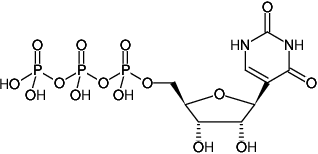Ψ-UTP
Pseudouridine-5'-triphosphate, Sodium Salt
| Cat. No. | Amount | Price (EUR) | Buy / Note |
|---|---|---|---|
| NU-1139S | 10 μl (100 mM) | 64,54 | Add to Basket/Quote Add to Notepad |
| NU-1139L | 5 x 10 μl (100 mM) | 291,31 | Add to Basket/Quote Add to Notepad |

For general laboratory use.
Shipping: shipped on gel packs
Storage Conditions: store at -20 °C
Short term exposure (up to 1 week cumulative) to ambient temperature possible.
Shelf Life: 12 months after date of delivery
Molecular Formula: C9H15N2O15P3 (free acid)
Molecular Weight: 484.14 g/mol (free acid)
Exact Mass: 483.97 g/mol (free acid)
CAS#: 1175-34-4
Purity: ≥ 95 % (HPLC)
Form: solution in water
Color: colorless to slightly yellow
Concentration: 100 mM - 110 mM
pH: 7.5 ±0.5
Solubility: water
Spectroscopic Properties: λmax 265 nm ±2 nm, ε 7.9 L mmol-1 cm-1 (Tris-HCl pH 7.5)
Related products: HighYield T7 RNA Synthesis Kit, #RNT-101
BIOZ Product Citations:
Selected References:
Anderson et al. (2012) Nucleofection induces transient eIF2α phosphorylation by GCN2 and PERK. Gene Ther. doi: 10.1038/gt.2012.5.
Green et al. (2012) Activation of autoreactive B cells by endogenous TLR7 and TLR3 RNA ligands. J. Biol. Chem. 287 (47):39789.
Karikó et al. (2012) Increased Erythropoiesis in Mice Injected With Submicrogram Quantities of Pseudouridine-containing mRNA Encoding Erythropoietin. Mol Ther. 20 (5):984.
Warren et al. (2012) Feeder-free derivation of human induced pluripotent stem cells with messenger RNA. Sci Rep. 2:657.
Anderson et al. (2011) Nucleoside modifications in RNA limit activation of 2'-5'-oligoadenylate synthetase and increase resistance to cleavage by RNase L. Nucleic Acids Research. 39 (21):9329.
Karikó et al. (2011) Generating the optimal mRNA for therapy: HPLC purification eliminates immune activation and improves translation of nucleoside-modified, protein encoding mRNA. Nucleic Acids Research. 39 (21):e142.
Anderson et al. (2010) Incorporation of pseudouridine into mRNA enhances translation by dimishing PKR activation. Nucleic Acids Research. 38 (17):5884.
Warren et al. (2010) Highly Efficient Reprogramming to Pluripotency and Directed Differentiation of Human Cells with Synthetic Modified mRNA. Cell Stem Cell. doi:10.1016/j.stem.2010.08.012.
Karikó et al. (2008) Incorporation of Pseudouridine into mRNA yields superior nonimmunogenic vector with increased translational capacity and biological stability. Molecular Therapy. 16 (11):1833.
Belliot et al. (2005) Norovirus proteinase-polymerase and polymerase are both active forms of RNA-dependent RNA polymerase. Journal of Virology. 79 (4):2393.
Karikó et al. (2005) Suppression of RNA Recognition by Toll-like Receptors: The Impact of Nucleoside Modifiation and the Evolutionary Origin of RNA. Immunity. 23 (2):165.
Charette et al. (2000) Pseudouridine in RNA: what, where, how, and why. IUBMB Life. 49 (5):341.
Madore et al. (2000) Effect of modified nucleotides on Escherichia coli tRNAGlu structure and on its aminoacylation by glutamyl-tRNA synthetase. Predominant and distinct roles of the mnm5 and s2 modifications of U34. Eur J Biochem. 266 (3):1128.
Goldberg et al. (1963) Comparative utilization of pseudouridine triphosphate and uridine triphosphate by ribonucleic acid polymerase. J. Biol. Chem. 238 (5):1793.